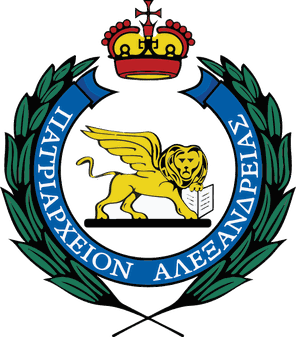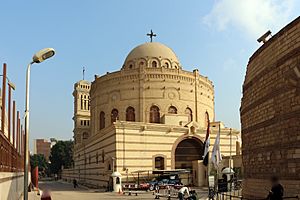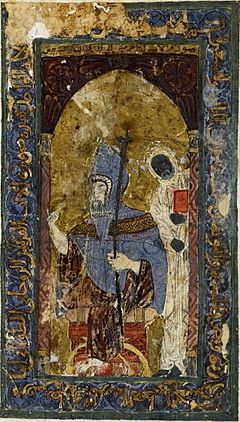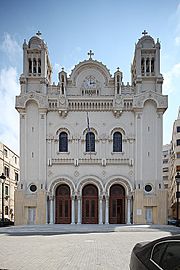Greek Orthodox Patriarchate of Alexandria facts for kids
Quick facts for kids Greek Orthodox Patriarchate of Alexandria and all Africa |
|
|---|---|

Seal
|
|
| Classification | Eastern Orthodox |
| Orientation | Greek Orthodoxy |
| Scripture | Septuagint, New Testament |
| Theology | Eastern Orthodox theology |
| Polity | Episcopal polity |
| Primate | Patriarch Theodore II of Alexandria |
| Language | Greek, Arabic, English, French, Portuguese, Swahili,Yoruba, and many other African languages |
| Headquarters | Alexandria and Cairo in Egypt |
| Territory | Africa |
| Possessions | None |
| Founder | The Apostle and Evangelist Mark |
| Independence | Apostolic Era |
| Recognition | Orthodox |
| Members | 500,000 - 1.5 millions |
The Greek Orthodox Patriarchate of Alexandria and all Africa is a major Christian church. It is also known as the Greek Orthodox Church of Alexandria. This church is part of the larger Eastern Orthodox Church. It is "autocephalous," which means it is independent and governs itself.
The church's main center is in Alexandria, a city in Egypt. It is responsible for all Orthodox Christians across the entire African continent. People often call it the Greek or Eastern Orthodox Patriarchate of Alexandria. This helps tell it apart from the Coptic Orthodox Patriarchate of Alexandria.
Followers of the Greek Orthodox Patriarchate were once called "Melkites." This name was used by other Christians who disagreed with a big church meeting in 451 AD. The Greek Orthodox stayed connected to the main church in Constantinople. Mark the Evangelist, one of Jesus's apostles, is believed to have started this church. The church's symbol is the Lion of Saint Mark.
The leader of the Patriarchate of Alexandria is called the Pope and Patriarch of Alexandria and all Africa. Currently, this leader is Theodore II of Alexandria. His full title is very long and important. He claims to be the successor of Mark the Evangelist. Mark founded the church in the 1st century, starting Christianity in Africa. This church is one of the five oldest and most important church centers, known as the Pentarchy. The main church building for the patriarchate is the Cathedral of the Annunciation in Alexandria.
Contents
History of the Patriarchate
The history of the Patriarchate of Alexandria includes many important early Christian leaders. Two famous ones were Athanasius and Cyril. They were patriarchs of Alexandria during important church meetings called ecumenical councils.
In 451 AD, a big church meeting called the Council of Chalcedon caused a split. The Church of Alexandria divided into two groups. Most of the local Egyptian Christians did not agree with the council's decisions. They became known as the Coptic Orthodox Church. A smaller group of Christians in Alexandria did follow the council's teachings. This group became the Greek Orthodox Church of Alexandria. They used Greek in their church services. These Greek Christians were loyal to the Eastern Roman Emperor. They also stayed connected with the church leaders in Rome, Antioch, Constantinople, and Jerusalem.
After the Arab conquest of Egypt in the 7th century, the region was separated from the Byzantine Empire. The Greek Orthodox Christians became a small group in Egypt. This church remained small for many centuries. These Christians in Alexandria stayed connected with the Patriarch of Constantinople and the Pope of Rome. During the Crusades, they even shared holy communion with Latin merchants. They also allowed Latin priests to use their own prayer books. The first clear sign of a split with Rome happened in 1310. That is when the Bishop of Rome appointed a separate Latin Patriarch of Alexandria.
Growth in the 1800s
In the 1800s, Orthodox Christianity in Africa started to grow again. This was partly because Orthodox people began moving to different parts of Africa. Many people from Greece, Syria, and Lebanon settled there. They started new Orthodox Churches. Many Greeks also moved to Alexandria starting in the 1840s. This helped Orthodoxy to become strong there again. New schools and printing presses were also built.
For a while, there was some confusion outside Egypt. Orthodox immigrants would form their own "communities." They would try to get a priest from their home country. It was not always clear which bishops were in charge of these priests.
By the 1920s, everyone agreed. All Orthodox churches in Africa would be under the care of the Patriarchate of Alexandria. This helped Africa avoid the confusion that happened in places like America and Australia.
Missionary Work in the 1900s
In Africa south of the Sahara Desert, Christianity grew mostly because of Western missionaries. These included Roman Catholic and Protestant groups. However, these churches were often linked to Western culture. Greek missions to Africa followed Greek-speaking settlers. They still provide cultural connections to Greece and the Greek church in Egypt.

Some African-led churches became interested in Orthodoxy. But it was hard for them to connect with the historic Orthodox Church. So, they looked further afield. In the 1920s, some of them contacted the African Orthodox Church in the USA. This church was not part of the main Eastern Orthodox Churches. Important figures were Daniel William Alexander in South Africa and Ruben Spartas Mukasa in Uganda.
In the 1930s, Daniel William Alexander visited Uganda and later Kenya. Spartas also contacted a missionary priest named Fr Nikodemos Sarikas in Tanganyika. Through him, Spartas connected with the Greek Patriarch of Alexandria. In 1946, the African Orthodox groups in Kenya and Uganda joined the Greek Orthodox Patriarchate of Alexandria.
In the 1950s, the Orthodox Church in Kenya faced hard times. The British colonial government caused problems during the Mau Mau Uprising. Many clergy were put in camps. Churches and schools were closed. Only the main church in Nairobi, which had mostly Greek members, stayed open. Archbishop Makarios III of Cyprus gave a speech against colonialism there. This led to a friendship between him and Jomo Kenyatta, a leader in Kenya's fight for independence.
After Kenya became independent in 1963, things got better. The Greek-speaking Church of Cyprus helped the Greek Orthodox Church in Kenya rebuild. They built a seminary and sent missionary teachers.
Recent Developments (Late 1900s to Early 2000s)
In recent years, Pope Petros VII led a big effort to spread the church. During his seven years as patriarch (1997–2004), he worked hard to share the Orthodox Christian faith in Arab nations and all over Africa. He helped train local clergy and encouraged using local languages in church services. He also worked to improve relations with the Coptic Orthodox Church. He signed an agreement allowing marriages between their members. His work ended sadly when he died in a helicopter crash in 2004. Several other clergy, including Bishop Nectarios of Madagascar, also died in the crash.
Today, about 300,000 Eastern Orthodox Christians belong to the Patriarchate of Alexandria in Egypt. This is the highest number since the time of the Roman Empire. The current leader of the Greek Church of Alexandria is Theodoros II. He is the Pope and Patriarch of Alexandria and all Africa.
2019 Schism with Moscow
On December 27, 2019, the Russian Orthodox Church officially broke ties with the Eastern Orthodox Patriarchate in Alexandria. This happened because the Patriarchate of Alexandria recognized the Orthodox Church of Ukraine. The Russian church does not accept the Ukrainian church's independence. This decision was made after Theodore II announced his support for the Church of Ukraine. The Russian Orthodox Church said it would remain connected with any clergy in Alexandria who disagreed with Theodore II's decision.
Church Leaders and Structure
The Greek Orthodox Patriarchate of Alexandria has a clear structure of leaders. These leaders help guide the church and its members across Africa.
Patriarch
- The main leader is Patriarch Theodore II (Choreftakis). He is the Pope and Patriarch of the Holy Archdiocese of Alexandria in Egypt. He is the head of the Greek Orthodox Patriarchate of Alexandria and All Africa.
Archbishops (Metropolitans)
The church is divided into many regions, each led by an Archbishop (also called a Metropolitan). These leaders oversee the church's work in their specific areas. Here are some of the Archbishops and their regions:
- Metropolitan Narcissus (Gammo) leads the Holy Archdiocese of Accra. This covers countries like Burkina Faso, Ghana, and Liberia.
- Metropolitan Peter (Giakoumelos) leads the Holy Archdiocese of Axum. This is in Addis Ababa and covers the Horn of Africa.
- Metropolitan Gennadius (Stantzios) leads the Holy Archdiocese of Botswana.
- Metropolitan Pantaleon (Arathymos) leads the Holy Archdiocese of Brazzaville and Gabon. This covers the Congo and Gabon.
- Metropolitan Gregory (Stergiou) leads the Holy Archdiocese of Cameroon. This covers Cameroon, the Central African Republic, and other nearby countries.
- Metropolitan Meletius (Koumanis) leads the Holy Archdiocese of Carthage. This is in Tunis and covers Algeria, Morocco, and Tunisia.
- Metropolitan Demetrius (Zacharengas) leads the Holy Archdiocese of Dar es Salaam. This covers eastern Tanzania and the Seychelles.
- Metropolitan Sergius (Kykkotis) leads the Holy Archdiocese of Good Hope. This is in Cape Town and covers parts of South Africa and nearby countries like Lesotho.
- Metropolitan Nicholas (Antoniou) leads the Holy Archdiocese of Hermopolis. This is in Tanta and serves Arabic-speaking Orthodox Christians in Egypt.
- Metropolitan Damascene (Papandreou) leads the Holy Archdiocese of Johannesburg and Pretoria. This covers northeastern South Africa.
- Metropolitan Jonah (Lwanga) leads the Holy Archdiocese of Kampala in Uganda.
- Metropolitan Meletius (Kamiloudis) leads the Holy Archdiocese of Katanga. This is in Lubumbashi in the Democratic Republic of the Congo.
- Metropolitan Nicephorus (Konstantinou) leads the Holy Archdiocese of Kinshasa in the Democratic Republic of the Congo.
- Metropolitan Gabriel (Raftopoulos) leads the Holy Archdiocese of Leontopolis. This is in Ismailia and covers northeastern Egypt.
- Metropolitan Ignatius (Sennis) leads the Holy Archdiocese of Madagascar. This covers Madagascar and nearby islands like the Comoros.
- Metropolitan Nicodemus (Priangelos) leads the Holy Archdiocese of Memphis. This is in Heliopolis.
- Metropolitan Jerome (Muzeeyi) leads the Holy Archdiocese of Mwanza. This is in Bukoba and covers western Tanzania.
- Metropolitan Macarius (Telyridis) leads the Holy Archdiocese of Nairobi in Kenya.
- Metropolitan Alexander (Gianniris) leads the Holy Archdiocese of Nigeria. This covers Nigeria, Niger, Benin, and Togo.
- Metropolitan Savvas (Cheimonetos) leads the Holy Archdiocese of Nubia. This is in Khartoum and covers Sudan and South Sudan.
- Metropolitan Nephon (Tsavaris) leads the Holy Archdiocese of Pelusium. This is in Port Said.
- Metropolitan Emmanuel (Kagias) leads the Holy Archdiocese of Ptolemais. This is in Minya and covers Upper Egypt.
- Metropolitan Theophylact (Tzoumerkas) leads the Holy Archdiocese of Tripoli in Libya.
- Metropolitan Yohanis (Ιιοανις)(Tsaftaridis) leads the Holy Archdiocese of Zambia, Mozambique and Malawi. This is in Lusaka.
- Metropolitan Seraphim (Iakovou) leads the Holy Archdiocese of Zimbabwe and Angola. This is in Harare.
- Metropolitan Innocentius (Byakatonda) leads the Holy Archdiocese of Burundi and Rwanda.
Bishops
Bishops also lead specific areas, often smaller than Archdioceses.
- Bishop Chrysostome (Karagounis) leads the Holy Diocese of Mozambique.
- Bishop Neophytos (Kongai) leads the Holy Diocese of Nyeri and Mount Kenya.
- Bishop Athanasius (Akunda) leads the Holy Diocese of Kisumu and Western Kenya.
- Bishop Agathonicus (Nikolaidis) leads the Holy Diocese of Arusha and Central Tanzania.
- Bishop Silvestros (Kisitu) leads the Holy Diocese of (Gulu) and eastern Uganda.
Greek Orthodox Churches in Egypt
Here is a list of some Greek Orthodox Churches located in Egypt:
- St. Constantine and St. Helena Church – Cairo
- St. Spyridon Church – Helwan
- Patriarchal Monastery of St. George – Old Cairo
- St. Nicholas Church - Heliopolis
- Church of the Archangels - Al-Zahir
- Our Lady of El Nayah Church – Alexandria
- St. Anthony the Great Shatby – Alexandria
- The Annunciation of the Virgin Mary Church – Mansheya, Alexandria
- Patriarchal Monastery of Saint Savvas of the Blessed Virgin of Alexandria
- Church of the Entry of Christ into the Temple – Tanta
- St. George Church – Tanta
- Saint Nicholas Church – Mansoura
- Saint Nicholas Church – Port Said
- St. Nicholas Church – Old Patriarchate, Damietta
- The Most Holy Theotokos Church - Heliopolis
See also
 In Spanish: Iglesia ortodoxa de Alejandría para niños
In Spanish: Iglesia ortodoxa de Alejandría para niños
- List of Greek Orthodox Patriarchs of Alexandria
- Greek Orthodox Church
- Greeks in Egypt
- Syro-Lebanese in Egypt




